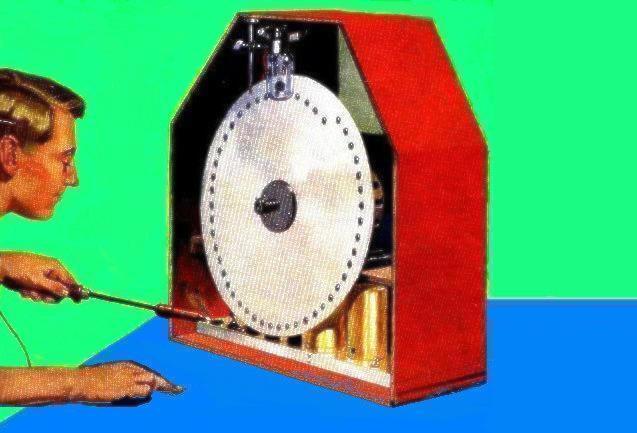
Early Amateur Involvement. Radio amateurs and experimenters figured prominently in early television development. Depression economics and uncertainty about changing television standards prevented people from buying sets. Yet popular radio and science magazines published plans for building sets.
S.S. Kresge and Sears sold parts such as scanning discs, neon tubes and television amplifiers. For a few dollars more or less, you could buy an entire kit. Amateurs were quite capable of adapting such materials to ever changing standards. Thousands built sets. They did it just for the thrill of pulling motion pictures out of the air.
Amateur Activity Today. Today's mechanical television hobby mostly focuses on recreating and even reinventing long-lost equipment. Some hobbyists also collect original equipment, but it has become quite rare. New awareness of the original television boom serves as the focus for brand new museums.
Only a few hobbyists have recreated programming, so if programming is your interest, then welcome! Opportunity awaits you. Preparing programming for this very different television medium should prove both challenging and rewarding.
Mechanical television isn't just about history. In fact, history is only the beginning. You'll find mechanical television technology in diverse commercial products. These include graphic scanners, video cassette recorders, opto interrupters, DVDs and fax machines. Many other devices use the technology, too.
These contemporary devices inspire hobbyist inventions. Surplus contemporary devices also provide parts such as motors, pulleys and sensors.
Parts Substitution. With original parts becoming rare and quite valuable, experimenters apply more up-to-date electronics to their hobby mechanical television creations. Many builders have become quite adept at substituting modern components for long-obsolete parts. Part of the hobby is inventing, and inventing begins with substitution.
For example, consider the neon kine tube. The successor to this bygone device is the LED matrix. Today, LED matrices can display mechanical television pictures in traditional orange or in a rainbow of colors.
Here are some other advantages of applying contemporary electronics...
- LEDs operate on much lower voltages than original neon television lamps necessitate.
- Transistors require far less massive chassis than tubes do.
- You can acquire semiconductors easily and inexpensively.
- A small piece of perfboard will hold an entire breadboard project and allow you to experiment for weeks.
- The power source may be flashlight batteries or a wall wart, available at a hamfest.
- The power supply brings up another advantage of transistors: The lack of a filament means that they operate far more efficiently than tubes do.
- The newest transistors, even general purpose types such as the 2N2222A, also offer fairly high gain. The gain is important in a preamp, because it allows a higher impedance circuit. Also in a pre-drive, current gain stage, you might only need one transistor instead of two.
Integrated circuits, while not as cheap as transistors, offer high impedance, and the advantage of noise-canceling differential inputs. Only use integrated circuits with a high gain-bandwidth product (GBP). Unlike general-purpose transistors, general purpose ICs such as the uA741 don't offer a sufficient GBP.
Advantages of the Hobby. As a hobby, mechanical television offers valuable advantages...
- Friendship in a world-wide society of amateur inventors
- A thrill like no other. Send and receive motion pictures on equipment you've built!
- Scientific inquiry. The joy of discovery as you design, test and build your equipment
- Skill development in several areas including electronics, optics and mechanics
- Experience history. Inventing, building and using television equipment provides a first-hand perspective
- Satisfaction in achievement. Advancement bears tangible results. Your success is your pride.
Mechanical Television Clubs. Mechanical television has been my hobby for decades. I'm quite happy to report that both mechanical television and the hobby are still with us.
|
An international club supports the mechanical television hobby community. We members build, improve, restore and demonstrate mechanical television equipment. Check out the Narrow Bandwidth Television Association (NBTVA). Until recently, the Experimental Television Society (ETS) performed a similar function. |
Steve McVoy's independent group "ETF" meets annually for a convention in Hilliard, Ohio. The group concerns itself with all aspects of early television and television history. The associated ETF museum in Hilliard contains an impressive collection of working mechanical and electronic television sets. So that you can see the sets in action, the museum provides programming in several obsolete TV formats. See Early Television Foundation.
Standards. Today, mechanical television belongs to the hobbyists. Standards tend to be a matter for personal speculation, rather than a requirement. If you belong to a mechanical television club, the situation changes. Then you probably want to communicate with your fellows. Both the NBTVA and ETS have adopted a 32-line standard. This standard derives from the sequential-scanning cameras of John Logie Baird...
- Lines. 32 lines, sequentially scanned
- Scanning type. Vertical scanning by Nipkow disc
- Scanning direction. Counterclockwise, bottom to top, right to left
- Line sync. Blacker than black pulse at the end of each vertical line
- Frame sync. Missing horizontal pulse at line 32
- Transmission. Few amateurs transmit pictures, but the number may be growing.
- Programming. Available on club-distributed CDs. Documentary footage and test patterns.
Paul Nipkow and his associates really started something big.